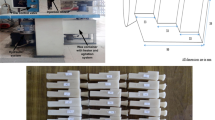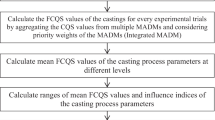Abstract
The present investigation focuses on optimizing the injection process parameters with multiple performance characteristics in the investment casting process using the orthogonal array with grey–fuzzy logics. A grey–fuzzy reasoning grade obtained from the grey–fuzzy logics analysis is used as a performance index to determine the optimal injection process parameters. The selected injection process parameters are injection temperature, injection time, and injection pressure, while the considered performance characteristics are linear shrinkage and surface finish. The response table, response graph, and analysis of variance are used to find the optimal setting and the influence of injection process parameters on the multiple performance characteristics. The results of confirmation experiments reveal that grey–fuzzy logics can effectively acquire an optimal combination of the process parameters. Hence, quality of wax patterns in the investment casting process can be significantly improved through this approach.
Similar content being viewed by others
References
Clegg AJ (1991) Precision casting processes. Pergamon, Oxford, p 293
Jain PL (2008) Principles of foundry technology, 4th edn. McGraw-Hill, New Delhi, pp 14–15
Solomon P (1973) Disposable pattern composition for making same and method of investment casting, US Patent No. 3754943
Brown JR, Barlow J, Bastin SB, Bill D, Birch JM, Calvert AB (1997) The investment casting process. Foundryman 90:175–181
Tascioglu S, Akar N (2003) Conversion of an investment casting sprue wax to a pattern wax by chemical agents. Mater Manuf Process 18:753–768
Bonilla W, Masood SH, Iovenitti P (2001) An investigation of wax patterns for accuracy improvement in investment cast parts. Int J Adv Manuf Tech 18:348–356
Rezavand SAM, Behravesh AH (2007) An experimental investigation on dimensional stability of injected wax patterns of gas turbine blades. J Mater Process Technol 182:580–587
Horacek M (1997) Accuracy of castings manufactured by lost wax process. Proceedings of the 23rd BICTA Conference, UK 2, 1–20
Singh B, Kumar P, Mishra BK (2006) Experimental investigation of wax blends in investment casting process. Indian Foundry J 52(3):29–36
Horacek M, Lubos S (1996) Influence of injection parameters on the dimensional stability of wax patterns. 9th World Conference on Investment Casting, San Francisco, California
Gaitonde VN, Karnik SR, Achyutha BT, Siddeswarappa B (2007) Methodology of Taguchi optimization for multi-objective drilling problem to minimize burr size. Int J Adv Manuf Technol 34:1–8
Kumar S, Kumar P, Shan HS (2008) Density optimization of slurry of coating material used in the EPC process through Taguchi’s parameter design approach. Mater Manuf Process 23:719–725
Kumar P, Barua PB, Gaindher JL (1996) Quality of V-process method through the Taguchi technique. Qual Reliab Eng Int 12:421–427
Caleb Li MH, Hong SM (2005) Optimal parameter design for chip-on-film technology using the Taguchi method. Int J Adv Manuf Technol 25:118–129
Jean MD, Tzeng YF (2004) Optimization of election-beam surface hardening of cast iron for high wear resistance using the Taguchi method. Int J Adv Manuf Technol 24:190–198
Tosun N (2006) Determination of optimum parameters for multi-performance characteristics in drilling by using grey relational analysis. Int J Adv Manuf Technol 27:450–455
Asokan P, Ravi Kumar R, Jeyapaul R, Santhi M (2008) Development of multi-objective optimization models for electrochemical machining process. Int J Adv Manuf Technol 39:55–63
Tarng YS, Juang SC, Chang CH (2002) The use of grey-based Taguchi methods to determine submerged arc welding process parameters in hardfacing. J Mater Process Technol 128:1–6
Ilo S, Just C, Xhiku F (2012) Optimisation of multiple quality characteristics of hardfacing using grey-based Taguchi method. Mater Des 33:459–468
Zadeh L (1965) Fuzzy sets. Inf Control 8:338–353
Liu NM, Horng JT, Chiang KT (2009) The method of grey-fuzzy logic for optimizing multi-response problems during the manufacturing process: a case study of the light guide plate printing process. Int J Adv Manuf Technol 41:200–210
Chiang KT, Chang FP, Tsai TC (2006) Optimum design parameters of Pin-Fin heat sink using the grey–fuzzy logic based on the orthogonal arrays. Int Commun Heat Mass Transfer 33:744–752
Lin JL, Lin CL (2005) The use of grey–fuzzy for the optimization of the manufacturing process. J Mater Process Technol 160:9–14
Wang YC, Li DY, Peng YH, Zeng XQ (2007) Numerical simulation of low pressure die casting of magnesium wheel. Int J Adv Manuf Technol 38:257–264
Singh PN, Raghukandan K, Pai BC (2004) Optimization by grey relational analysis of EDM parameters on machining Al-10 % SiCp composites. J Mater Process Technol 155:1658–1661
Lu HS, Chen JY, Chung CT (2008) The optimal cutting parameter design of rough cutting process in side milling. J Achieve Mater Manuf Eng 29:183–186
Chiang KT, Chang FP (2006) Application of grey–fuzzy logic on the optimal process design of an injection-molded part with a thin shell features. Int Commun Heat Mass Transfer 33:94–101
Ahilan C, Kumanan S, Shivakamaran N (2009) Multi objective optimization of CNC turning process using grey based fuzzy logic. Int J Mach Mach Mater 5:434–451
Singh B, Kumar P, Mishra BK (2010) Investigations of the effect of injection parameters on the dimensional accuracy of wax patterns used in ceramic shell investment casting. Int J Manuf Technol Manage 21:148–159
Lin CL (2004) Use of the Taguchi method and grey relational analysis to optimize turning operations with multiple performance characteristics. Mater Manuf Process 19(2):209–220
Kao CC, Lu HS (2007) The optimal cutting-parameter selection of heavy cutting process in side milling for SUS304 stainless steel. Int J Adv Manuf Technol 34:440–447
Ross PJ (1988) Taguchi techniques for quality engineering, loss function, orthogonal experiments, parameter and tolerance design. McGraw-Hill, New York
Author information
Authors and Affiliations
Corresponding author
Rights and permissions
About this article
Cite this article
Pattnaik, S., Karunakar, D.B. & Jha, P.K. Multi-characteristic optimization of wax patterns in the investment casting process using grey–fuzzy logic. Int J Adv Manuf Technol 67, 1577–1587 (2013). https://doi.org/10.1007/s00170-012-4591-4
Received:
Accepted:
Published:
Issue Date:
DOI: https://doi.org/10.1007/s00170-012-4591-4




